Harrisburg University: Plastic Bag Reduction Through Technology Report
VerifiedAdded on 2020/04/21
|45
|8511
|277
Report
AI Summary
This report, submitted to Harrisburg University of Science and Technology, investigates the impact of advanced technology on reducing plastic bag usage, addressing a significant environmental concern. The study explores the problem statement, the significance of the research, and the background of plastic manufacturing and its environmental consequences. It examines the research hypothesis, objectives, and questions, along with limitations and delimitations. A comprehensive literature review covers factors affecting the study, relevant theories, and methodologies. The research methodology outlines the research philosophy, design, strategy, data collection, analysis, sampling, and ethical considerations. The results section presents findings from descriptive and inferential analyses, including hypothesis testing. The report concludes with recommendations for reducing plastic waste and improving environmental sustainability, emphasizing the role of innovative technologies and government strategies.
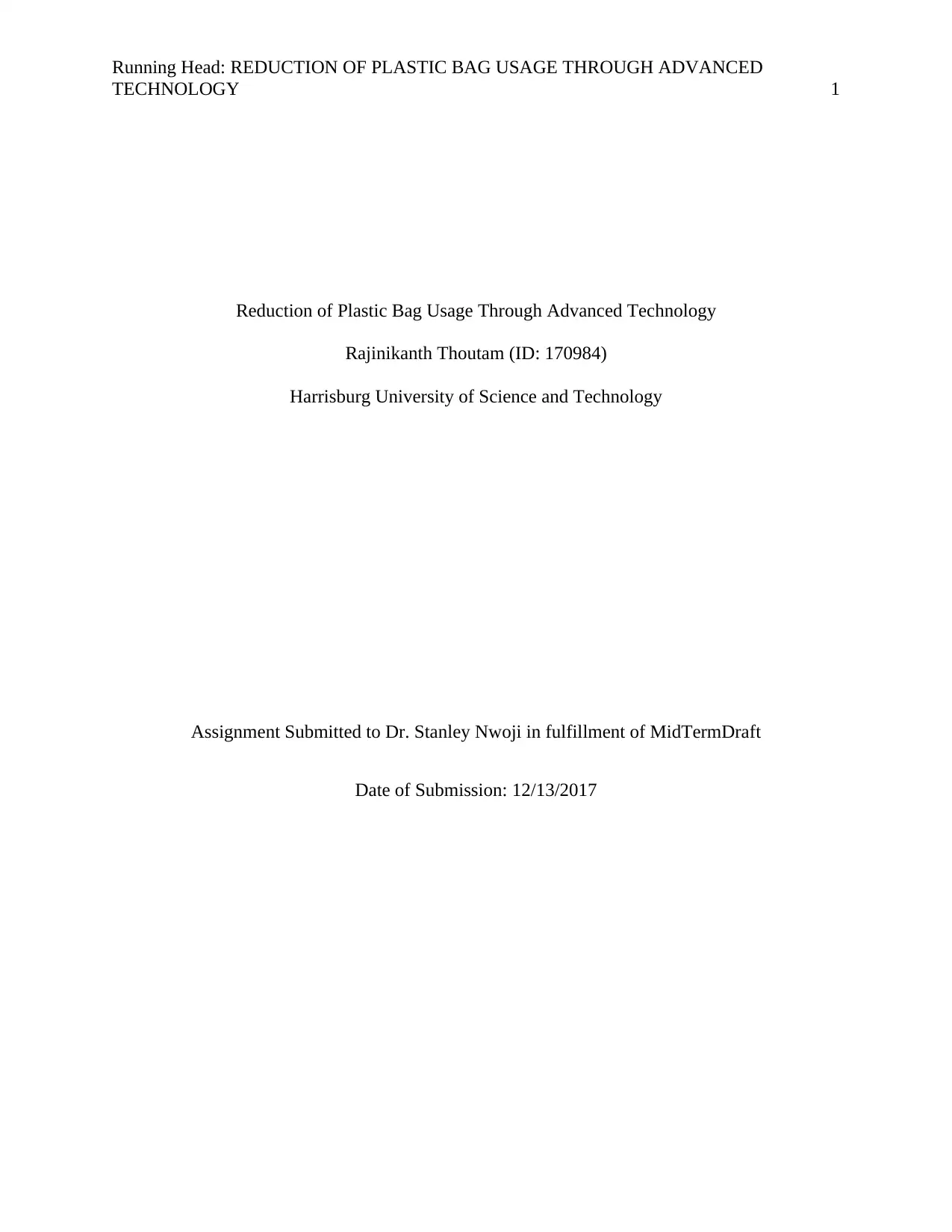
Running Head: REDUCTION OF PLASTIC BAG USAGE THROUGH ADVANCED
TECHNOLOGY 1
Reduction of Plastic Bag Usage Through Advanced Technology
Rajinikanth Thoutam (ID: 170984)
Harrisburg University of Science and Technology
Assignment Submitted to Dr. Stanley Nwoji in fulfillment of MidTermDraft
Date of Submission: 12/13/2017
TECHNOLOGY 1
Reduction of Plastic Bag Usage Through Advanced Technology
Rajinikanth Thoutam (ID: 170984)
Harrisburg University of Science and Technology
Assignment Submitted to Dr. Stanley Nwoji in fulfillment of MidTermDraft
Date of Submission: 12/13/2017
Paraphrase This Document
Need a fresh take? Get an instant paraphrase of this document with our AI Paraphraser
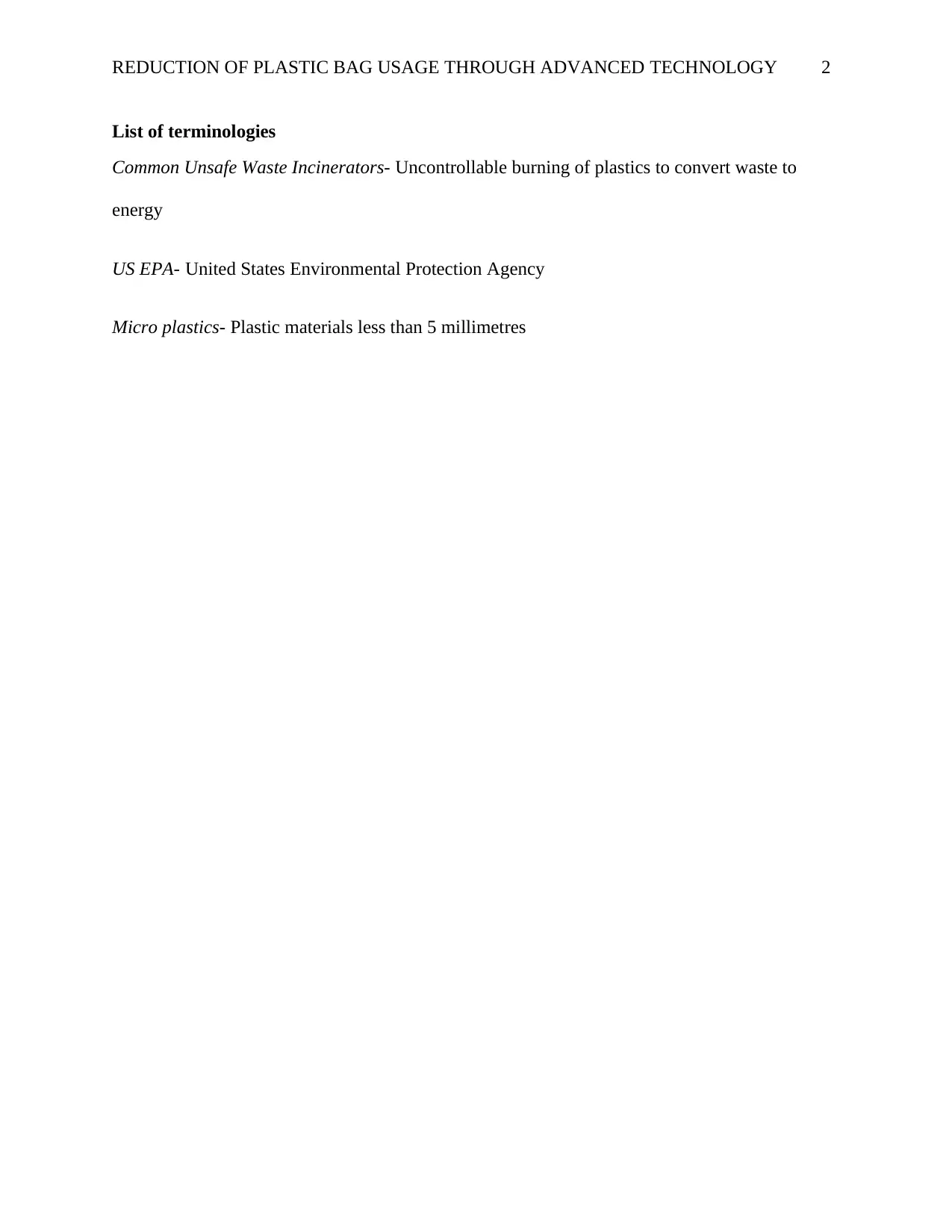
REDUCTION OF PLASTIC BAG USAGE THROUGH ADVANCED TECHNOLOGY 2
List of terminologies
Common Unsafe Waste Incinerators- Uncontrollable burning of plastics to convert waste to
energy
US EPA- United States Environmental Protection Agency
Micro plastics- Plastic materials less than 5 millimetres
List of terminologies
Common Unsafe Waste Incinerators- Uncontrollable burning of plastics to convert waste to
energy
US EPA- United States Environmental Protection Agency
Micro plastics- Plastic materials less than 5 millimetres
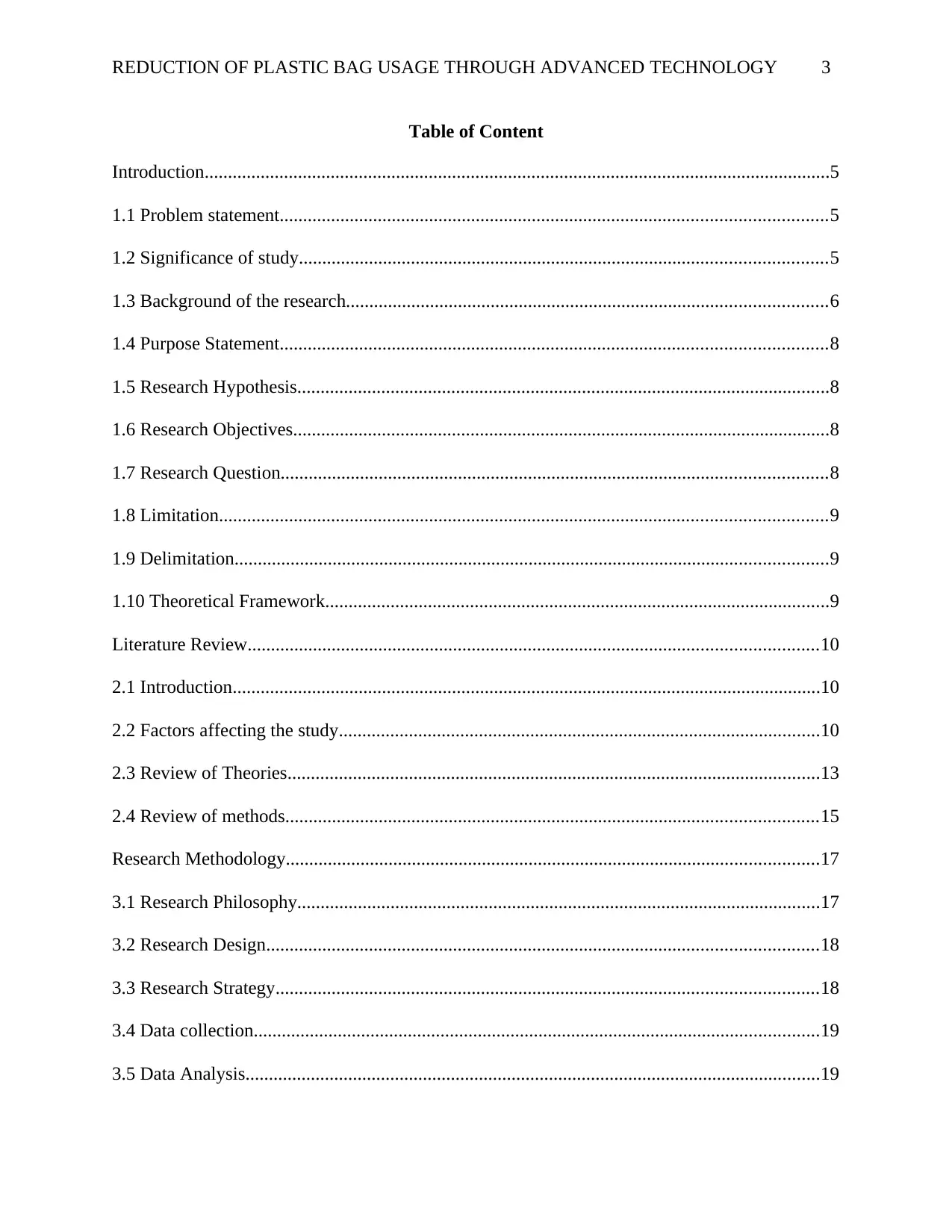
REDUCTION OF PLASTIC BAG USAGE THROUGH ADVANCED TECHNOLOGY 3
Table of Content
Introduction......................................................................................................................................5
1.1 Problem statement.....................................................................................................................5
1.2 Significance of study.................................................................................................................5
1.3 Background of the research.......................................................................................................6
1.4 Purpose Statement.....................................................................................................................8
1.5 Research Hypothesis..................................................................................................................8
1.6 Research Objectives...................................................................................................................8
1.7 Research Question.....................................................................................................................8
1.8 Limitation..................................................................................................................................9
1.9 Delimitation...............................................................................................................................9
1.10 Theoretical Framework............................................................................................................9
Literature Review..........................................................................................................................10
2.1 Introduction..............................................................................................................................10
2.2 Factors affecting the study.......................................................................................................10
2.3 Review of Theories..................................................................................................................13
2.4 Review of methods..................................................................................................................15
Research Methodology..................................................................................................................17
3.1 Research Philosophy................................................................................................................17
3.2 Research Design......................................................................................................................18
3.3 Research Strategy....................................................................................................................18
3.4 Data collection.........................................................................................................................19
3.5 Data Analysis...........................................................................................................................19
Table of Content
Introduction......................................................................................................................................5
1.1 Problem statement.....................................................................................................................5
1.2 Significance of study.................................................................................................................5
1.3 Background of the research.......................................................................................................6
1.4 Purpose Statement.....................................................................................................................8
1.5 Research Hypothesis..................................................................................................................8
1.6 Research Objectives...................................................................................................................8
1.7 Research Question.....................................................................................................................8
1.8 Limitation..................................................................................................................................9
1.9 Delimitation...............................................................................................................................9
1.10 Theoretical Framework............................................................................................................9
Literature Review..........................................................................................................................10
2.1 Introduction..............................................................................................................................10
2.2 Factors affecting the study.......................................................................................................10
2.3 Review of Theories..................................................................................................................13
2.4 Review of methods..................................................................................................................15
Research Methodology..................................................................................................................17
3.1 Research Philosophy................................................................................................................17
3.2 Research Design......................................................................................................................18
3.3 Research Strategy....................................................................................................................18
3.4 Data collection.........................................................................................................................19
3.5 Data Analysis...........................................................................................................................19
⊘ This is a preview!⊘
Do you want full access?
Subscribe today to unlock all pages.

Trusted by 1+ million students worldwide
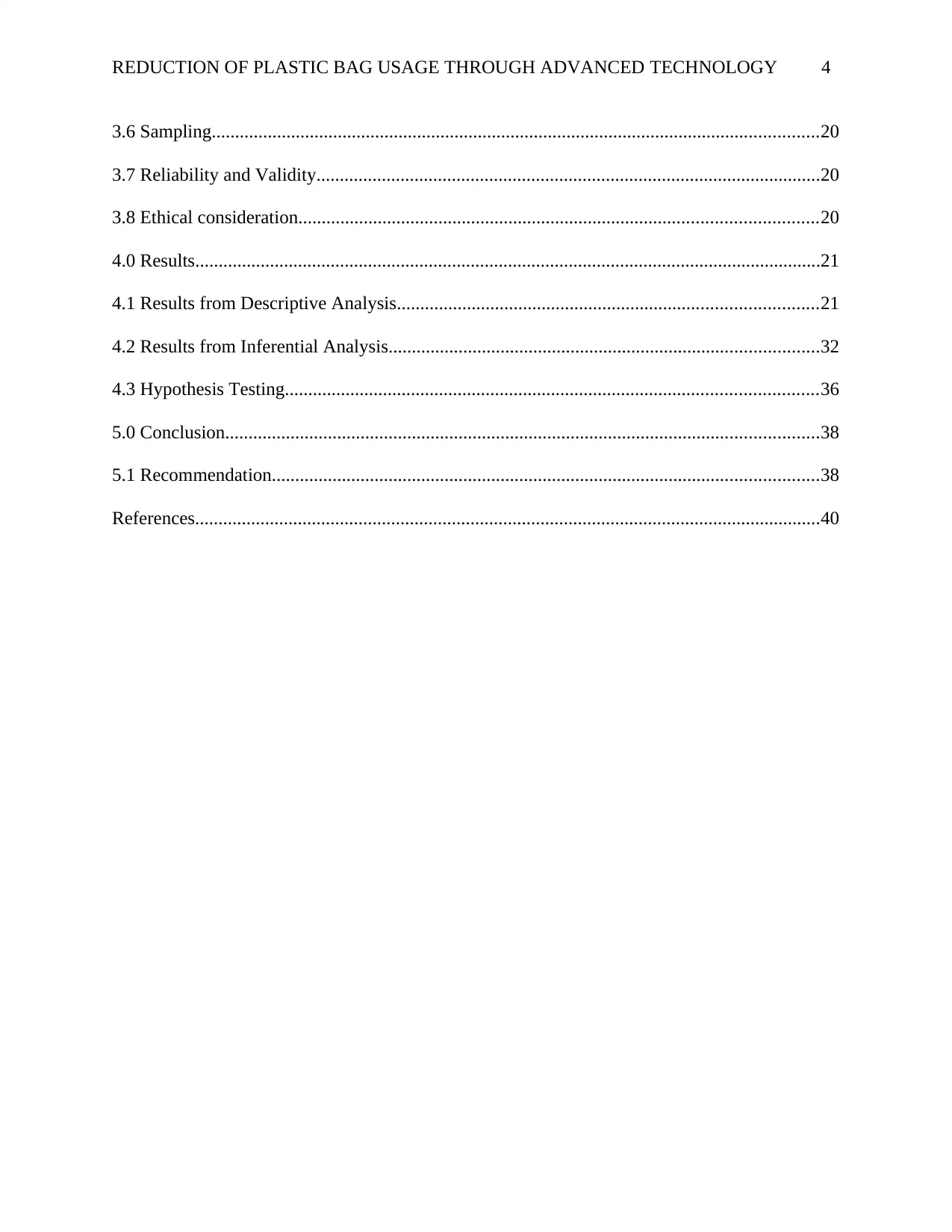
REDUCTION OF PLASTIC BAG USAGE THROUGH ADVANCED TECHNOLOGY 4
3.6 Sampling..................................................................................................................................20
3.7 Reliability and Validity............................................................................................................20
3.8 Ethical consideration...............................................................................................................20
4.0 Results......................................................................................................................................21
4.1 Results from Descriptive Analysis..........................................................................................21
4.2 Results from Inferential Analysis............................................................................................32
4.3 Hypothesis Testing..................................................................................................................36
5.0 Conclusion...............................................................................................................................38
5.1 Recommendation.....................................................................................................................38
References......................................................................................................................................40
3.6 Sampling..................................................................................................................................20
3.7 Reliability and Validity............................................................................................................20
3.8 Ethical consideration...............................................................................................................20
4.0 Results......................................................................................................................................21
4.1 Results from Descriptive Analysis..........................................................................................21
4.2 Results from Inferential Analysis............................................................................................32
4.3 Hypothesis Testing..................................................................................................................36
5.0 Conclusion...............................................................................................................................38
5.1 Recommendation.....................................................................................................................38
References......................................................................................................................................40
Paraphrase This Document
Need a fresh take? Get an instant paraphrase of this document with our AI Paraphraser
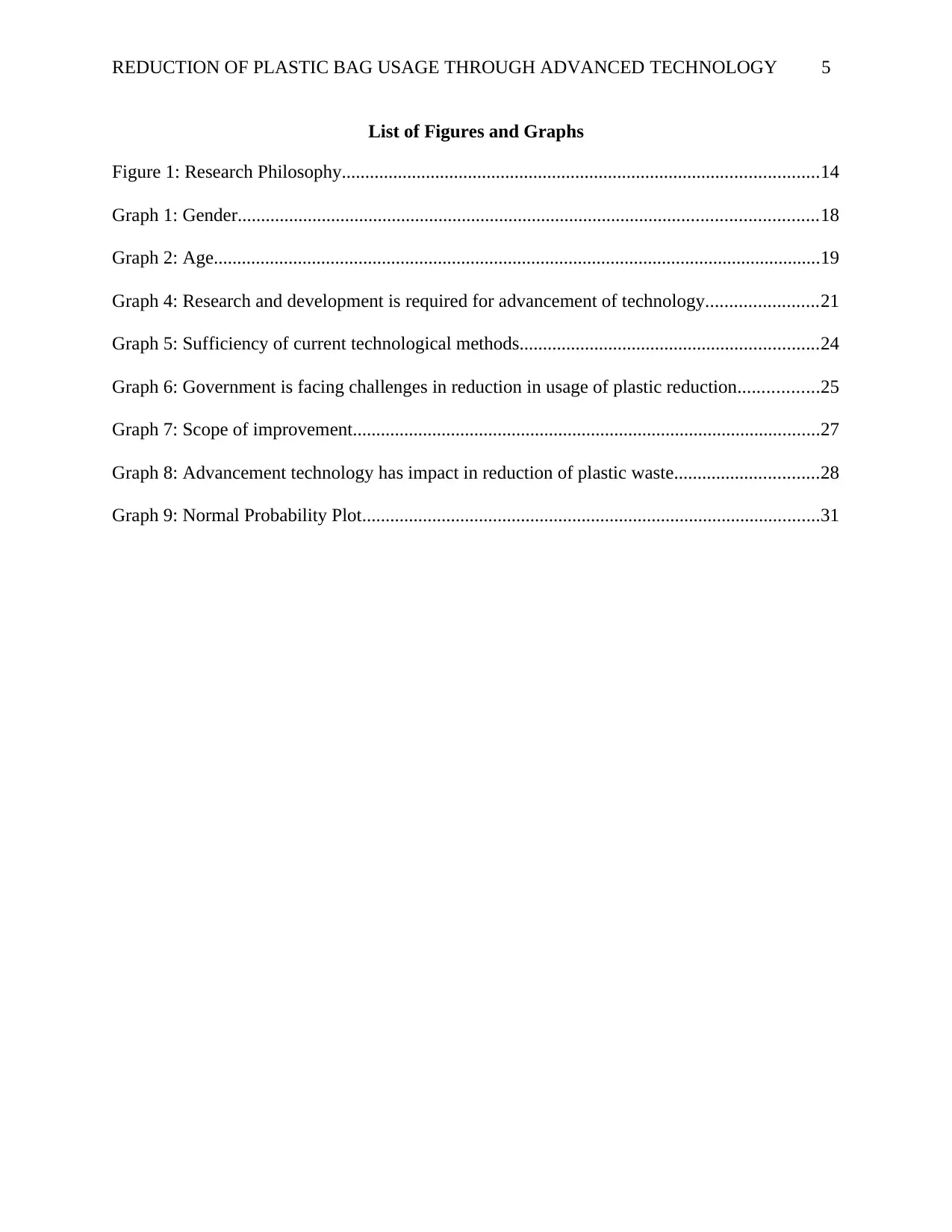
REDUCTION OF PLASTIC BAG USAGE THROUGH ADVANCED TECHNOLOGY 5
List of Figures and Graphs
Figure 1: Research Philosophy......................................................................................................14
Graph 1: Gender............................................................................................................................18
Graph 2: Age..................................................................................................................................19
Graph 4: Research and development is required for advancement of technology........................21
Graph 5: Sufficiency of current technological methods................................................................24
Graph 6: Government is facing challenges in reduction in usage of plastic reduction.................25
Graph 7: Scope of improvement....................................................................................................27
Graph 8: Advancement technology has impact in reduction of plastic waste...............................28
Graph 9: Normal Probability Plot..................................................................................................31
List of Figures and Graphs
Figure 1: Research Philosophy......................................................................................................14
Graph 1: Gender............................................................................................................................18
Graph 2: Age..................................................................................................................................19
Graph 4: Research and development is required for advancement of technology........................21
Graph 5: Sufficiency of current technological methods................................................................24
Graph 6: Government is facing challenges in reduction in usage of plastic reduction.................25
Graph 7: Scope of improvement....................................................................................................27
Graph 8: Advancement technology has impact in reduction of plastic waste...............................28
Graph 9: Normal Probability Plot..................................................................................................31
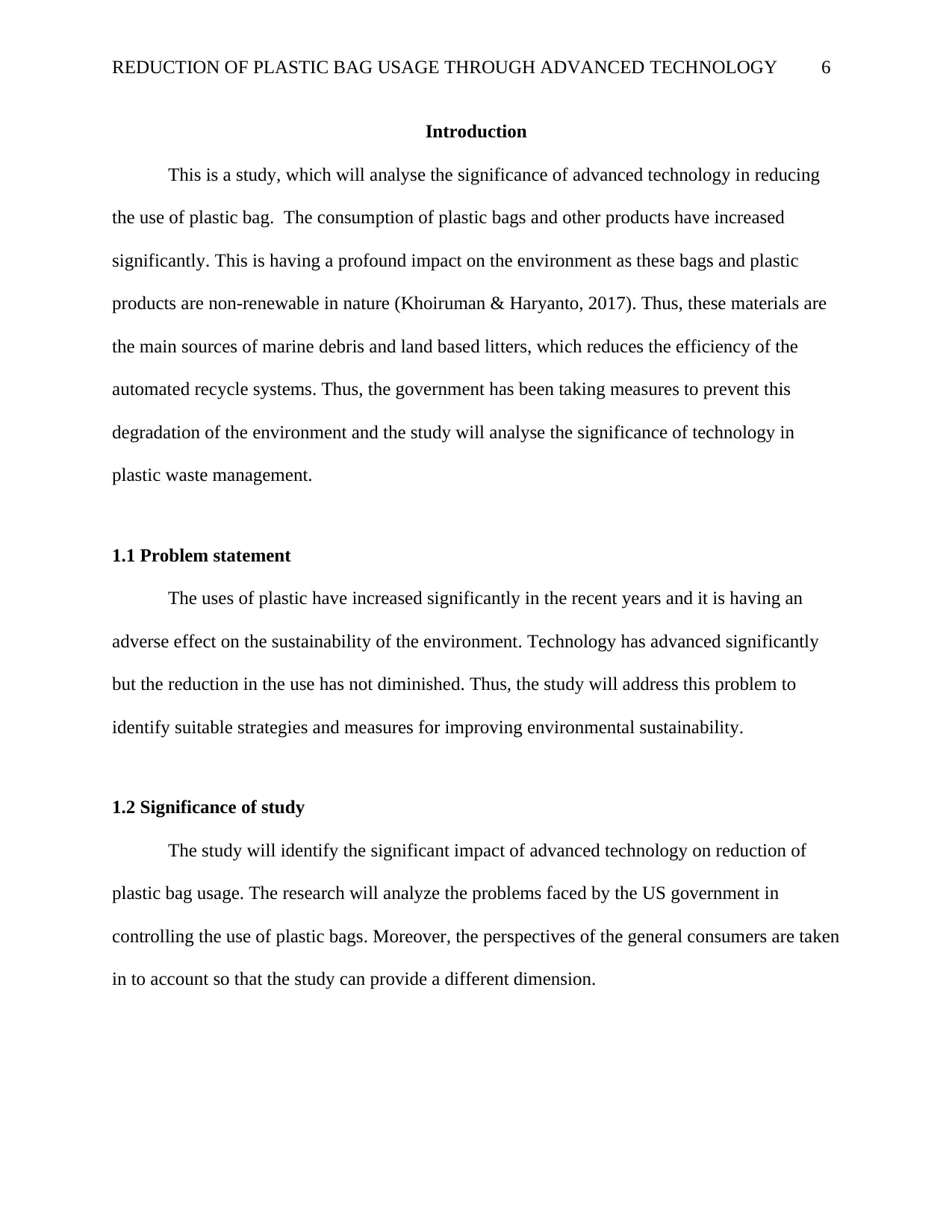
REDUCTION OF PLASTIC BAG USAGE THROUGH ADVANCED TECHNOLOGY 6
Introduction
This is a study, which will analyse the significance of advanced technology in reducing
the use of plastic bag. The consumption of plastic bags and other products have increased
significantly. This is having a profound impact on the environment as these bags and plastic
products are non-renewable in nature (Khoiruman & Haryanto, 2017). Thus, these materials are
the main sources of marine debris and land based litters, which reduces the efficiency of the
automated recycle systems. Thus, the government has been taking measures to prevent this
degradation of the environment and the study will analyse the significance of technology in
plastic waste management.
1.1 Problem statement
The uses of plastic have increased significantly in the recent years and it is having an
adverse effect on the sustainability of the environment. Technology has advanced significantly
but the reduction in the use has not diminished. Thus, the study will address this problem to
identify suitable strategies and measures for improving environmental sustainability.
1.2 Significance of study
The study will identify the significant impact of advanced technology on reduction of
plastic bag usage. The research will analyze the problems faced by the US government in
controlling the use of plastic bags. Moreover, the perspectives of the general consumers are taken
in to account so that the study can provide a different dimension.
Introduction
This is a study, which will analyse the significance of advanced technology in reducing
the use of plastic bag. The consumption of plastic bags and other products have increased
significantly. This is having a profound impact on the environment as these bags and plastic
products are non-renewable in nature (Khoiruman & Haryanto, 2017). Thus, these materials are
the main sources of marine debris and land based litters, which reduces the efficiency of the
automated recycle systems. Thus, the government has been taking measures to prevent this
degradation of the environment and the study will analyse the significance of technology in
plastic waste management.
1.1 Problem statement
The uses of plastic have increased significantly in the recent years and it is having an
adverse effect on the sustainability of the environment. Technology has advanced significantly
but the reduction in the use has not diminished. Thus, the study will address this problem to
identify suitable strategies and measures for improving environmental sustainability.
1.2 Significance of study
The study will identify the significant impact of advanced technology on reduction of
plastic bag usage. The research will analyze the problems faced by the US government in
controlling the use of plastic bags. Moreover, the perspectives of the general consumers are taken
in to account so that the study can provide a different dimension.
⊘ This is a preview!⊘
Do you want full access?
Subscribe today to unlock all pages.

Trusted by 1+ million students worldwide
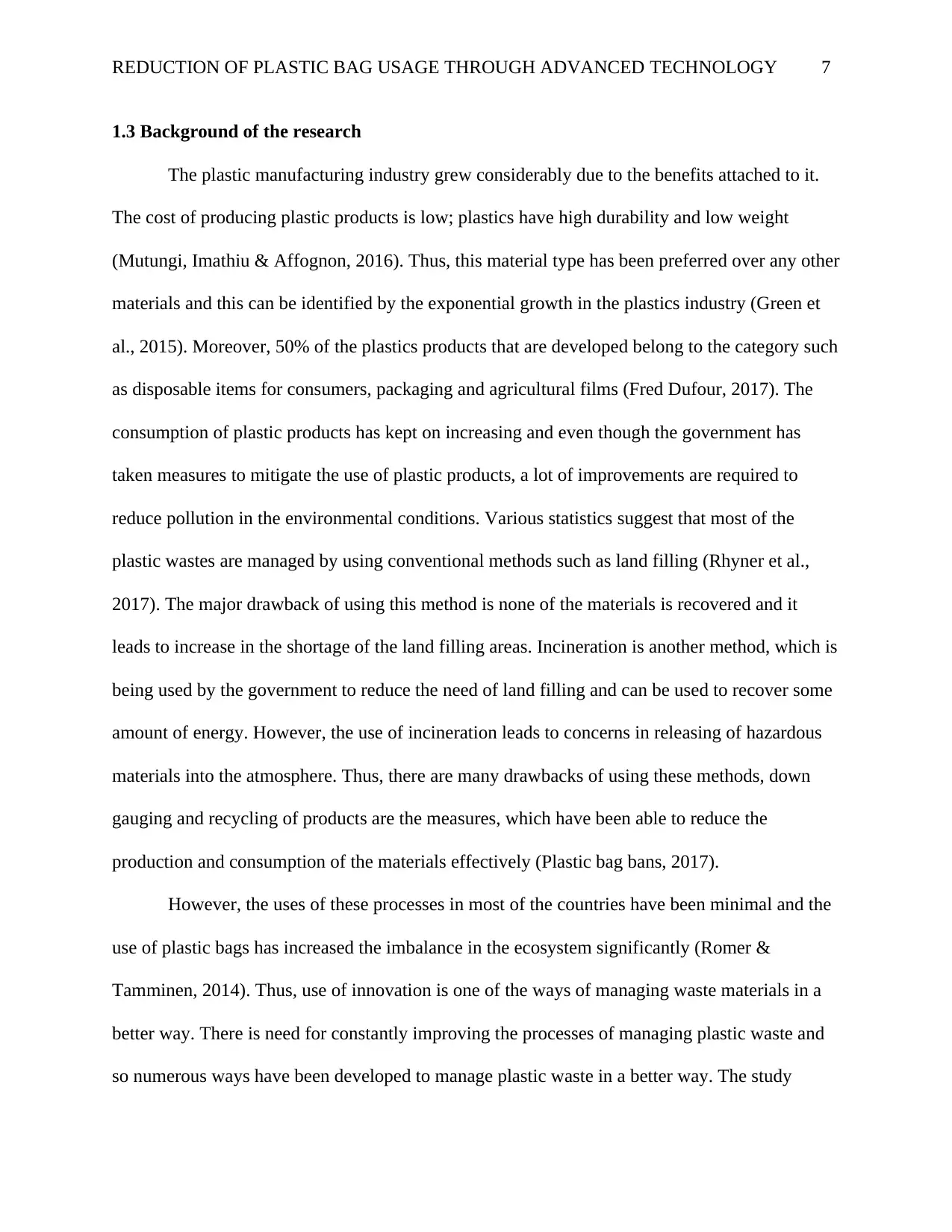
REDUCTION OF PLASTIC BAG USAGE THROUGH ADVANCED TECHNOLOGY 7
1.3 Background of the research
The plastic manufacturing industry grew considerably due to the benefits attached to it.
The cost of producing plastic products is low; plastics have high durability and low weight
(Mutungi, Imathiu & Affognon, 2016). Thus, this material type has been preferred over any other
materials and this can be identified by the exponential growth in the plastics industry (Green et
al., 2015). Moreover, 50% of the plastics products that are developed belong to the category such
as disposable items for consumers, packaging and agricultural films (Fred Dufour, 2017). The
consumption of plastic products has kept on increasing and even though the government has
taken measures to mitigate the use of plastic products, a lot of improvements are required to
reduce pollution in the environmental conditions. Various statistics suggest that most of the
plastic wastes are managed by using conventional methods such as land filling (Rhyner et al.,
2017). The major drawback of using this method is none of the materials is recovered and it
leads to increase in the shortage of the land filling areas. Incineration is another method, which is
being used by the government to reduce the need of land filling and can be used to recover some
amount of energy. However, the use of incineration leads to concerns in releasing of hazardous
materials into the atmosphere. Thus, there are many drawbacks of using these methods, down
gauging and recycling of products are the measures, which have been able to reduce the
production and consumption of the materials effectively (Plastic bag bans, 2017).
However, the uses of these processes in most of the countries have been minimal and the
use of plastic bags has increased the imbalance in the ecosystem significantly (Romer &
Tamminen, 2014). Thus, use of innovation is one of the ways of managing waste materials in a
better way. There is need for constantly improving the processes of managing plastic waste and
so numerous ways have been developed to manage plastic waste in a better way. The study
1.3 Background of the research
The plastic manufacturing industry grew considerably due to the benefits attached to it.
The cost of producing plastic products is low; plastics have high durability and low weight
(Mutungi, Imathiu & Affognon, 2016). Thus, this material type has been preferred over any other
materials and this can be identified by the exponential growth in the plastics industry (Green et
al., 2015). Moreover, 50% of the plastics products that are developed belong to the category such
as disposable items for consumers, packaging and agricultural films (Fred Dufour, 2017). The
consumption of plastic products has kept on increasing and even though the government has
taken measures to mitigate the use of plastic products, a lot of improvements are required to
reduce pollution in the environmental conditions. Various statistics suggest that most of the
plastic wastes are managed by using conventional methods such as land filling (Rhyner et al.,
2017). The major drawback of using this method is none of the materials is recovered and it
leads to increase in the shortage of the land filling areas. Incineration is another method, which is
being used by the government to reduce the need of land filling and can be used to recover some
amount of energy. However, the use of incineration leads to concerns in releasing of hazardous
materials into the atmosphere. Thus, there are many drawbacks of using these methods, down
gauging and recycling of products are the measures, which have been able to reduce the
production and consumption of the materials effectively (Plastic bag bans, 2017).
However, the uses of these processes in most of the countries have been minimal and the
use of plastic bags has increased the imbalance in the ecosystem significantly (Romer &
Tamminen, 2014). Thus, use of innovation is one of the ways of managing waste materials in a
better way. There is need for constantly improving the processes of managing plastic waste and
so numerous ways have been developed to manage plastic waste in a better way. The study
Paraphrase This Document
Need a fresh take? Get an instant paraphrase of this document with our AI Paraphraser
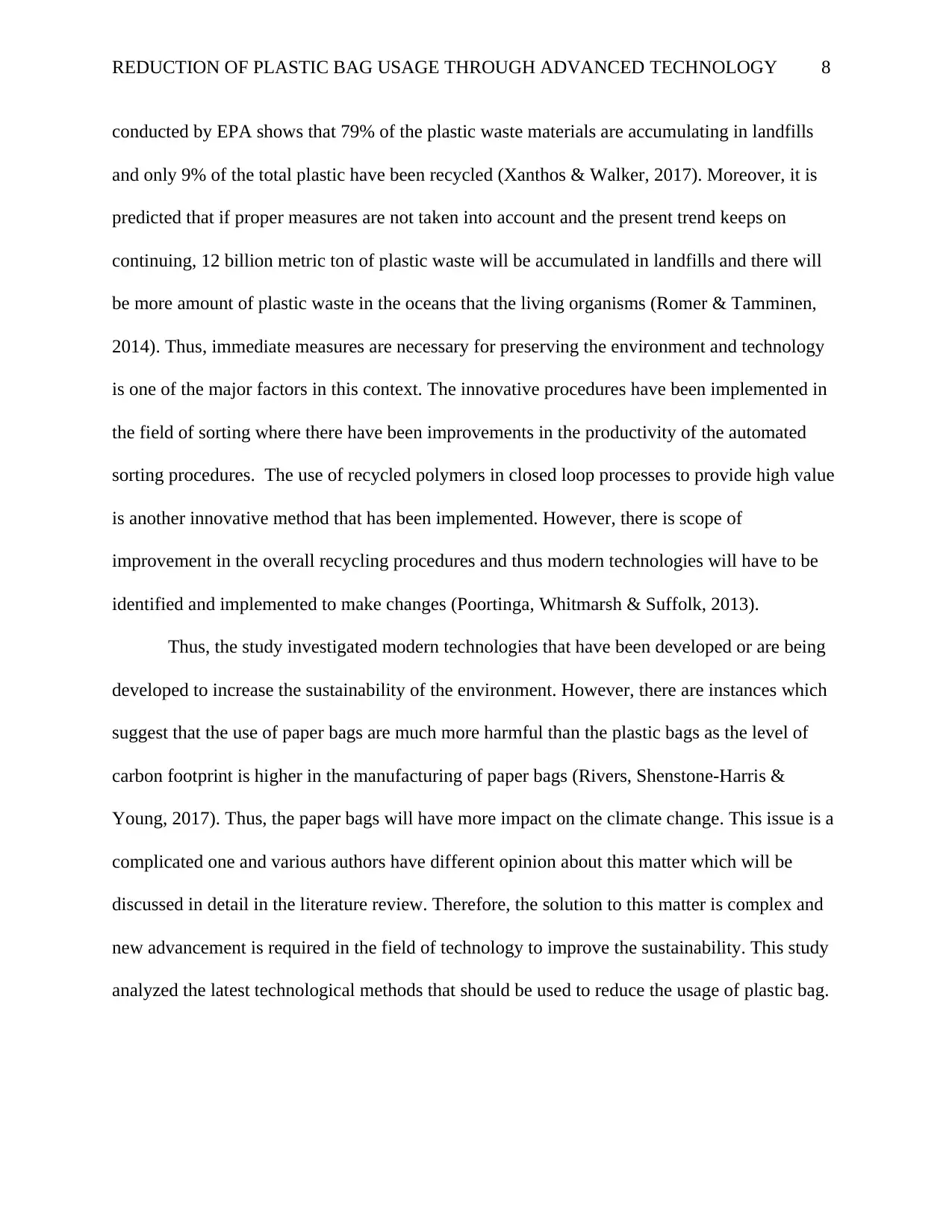
REDUCTION OF PLASTIC BAG USAGE THROUGH ADVANCED TECHNOLOGY 8
conducted by EPA shows that 79% of the plastic waste materials are accumulating in landfills
and only 9% of the total plastic have been recycled (Xanthos & Walker, 2017). Moreover, it is
predicted that if proper measures are not taken into account and the present trend keeps on
continuing, 12 billion metric ton of plastic waste will be accumulated in landfills and there will
be more amount of plastic waste in the oceans that the living organisms (Romer & Tamminen,
2014). Thus, immediate measures are necessary for preserving the environment and technology
is one of the major factors in this context. The innovative procedures have been implemented in
the field of sorting where there have been improvements in the productivity of the automated
sorting procedures. The use of recycled polymers in closed loop processes to provide high value
is another innovative method that has been implemented. However, there is scope of
improvement in the overall recycling procedures and thus modern technologies will have to be
identified and implemented to make changes (Poortinga, Whitmarsh & Suffolk, 2013).
Thus, the study investigated modern technologies that have been developed or are being
developed to increase the sustainability of the environment. However, there are instances which
suggest that the use of paper bags are much more harmful than the plastic bags as the level of
carbon footprint is higher in the manufacturing of paper bags (Rivers, Shenstone-Harris &
Young, 2017). Thus, the paper bags will have more impact on the climate change. This issue is a
complicated one and various authors have different opinion about this matter which will be
discussed in detail in the literature review. Therefore, the solution to this matter is complex and
new advancement is required in the field of technology to improve the sustainability. This study
analyzed the latest technological methods that should be used to reduce the usage of plastic bag.
conducted by EPA shows that 79% of the plastic waste materials are accumulating in landfills
and only 9% of the total plastic have been recycled (Xanthos & Walker, 2017). Moreover, it is
predicted that if proper measures are not taken into account and the present trend keeps on
continuing, 12 billion metric ton of plastic waste will be accumulated in landfills and there will
be more amount of plastic waste in the oceans that the living organisms (Romer & Tamminen,
2014). Thus, immediate measures are necessary for preserving the environment and technology
is one of the major factors in this context. The innovative procedures have been implemented in
the field of sorting where there have been improvements in the productivity of the automated
sorting procedures. The use of recycled polymers in closed loop processes to provide high value
is another innovative method that has been implemented. However, there is scope of
improvement in the overall recycling procedures and thus modern technologies will have to be
identified and implemented to make changes (Poortinga, Whitmarsh & Suffolk, 2013).
Thus, the study investigated modern technologies that have been developed or are being
developed to increase the sustainability of the environment. However, there are instances which
suggest that the use of paper bags are much more harmful than the plastic bags as the level of
carbon footprint is higher in the manufacturing of paper bags (Rivers, Shenstone-Harris &
Young, 2017). Thus, the paper bags will have more impact on the climate change. This issue is a
complicated one and various authors have different opinion about this matter which will be
discussed in detail in the literature review. Therefore, the solution to this matter is complex and
new advancement is required in the field of technology to improve the sustainability. This study
analyzed the latest technological methods that should be used to reduce the usage of plastic bag.
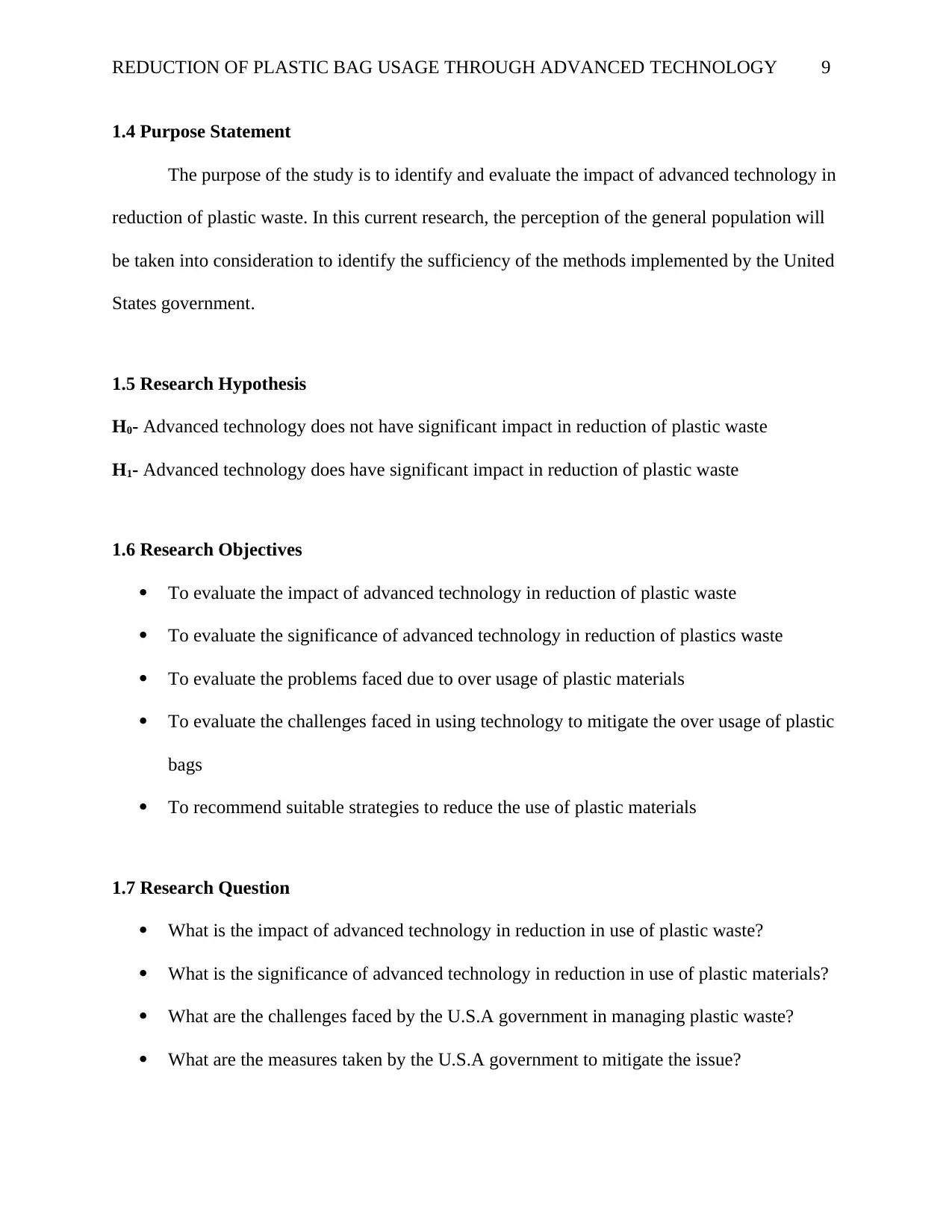
REDUCTION OF PLASTIC BAG USAGE THROUGH ADVANCED TECHNOLOGY 9
1.4 Purpose Statement
The purpose of the study is to identify and evaluate the impact of advanced technology in
reduction of plastic waste. In this current research, the perception of the general population will
be taken into consideration to identify the sufficiency of the methods implemented by the United
States government.
1.5 Research Hypothesis
H0- Advanced technology does not have significant impact in reduction of plastic waste
H1- Advanced technology does have significant impact in reduction of plastic waste
1.6 Research Objectives
To evaluate the impact of advanced technology in reduction of plastic waste
To evaluate the significance of advanced technology in reduction of plastics waste
To evaluate the problems faced due to over usage of plastic materials
To evaluate the challenges faced in using technology to mitigate the over usage of plastic
bags
To recommend suitable strategies to reduce the use of plastic materials
1.7 Research Question
What is the impact of advanced technology in reduction in use of plastic waste?
What is the significance of advanced technology in reduction in use of plastic materials?
What are the challenges faced by the U.S.A government in managing plastic waste?
What are the measures taken by the U.S.A government to mitigate the issue?
1.4 Purpose Statement
The purpose of the study is to identify and evaluate the impact of advanced technology in
reduction of plastic waste. In this current research, the perception of the general population will
be taken into consideration to identify the sufficiency of the methods implemented by the United
States government.
1.5 Research Hypothesis
H0- Advanced technology does not have significant impact in reduction of plastic waste
H1- Advanced technology does have significant impact in reduction of plastic waste
1.6 Research Objectives
To evaluate the impact of advanced technology in reduction of plastic waste
To evaluate the significance of advanced technology in reduction of plastics waste
To evaluate the problems faced due to over usage of plastic materials
To evaluate the challenges faced in using technology to mitigate the over usage of plastic
bags
To recommend suitable strategies to reduce the use of plastic materials
1.7 Research Question
What is the impact of advanced technology in reduction in use of plastic waste?
What is the significance of advanced technology in reduction in use of plastic materials?
What are the challenges faced by the U.S.A government in managing plastic waste?
What are the measures taken by the U.S.A government to mitigate the issue?
⊘ This is a preview!⊘
Do you want full access?
Subscribe today to unlock all pages.

Trusted by 1+ million students worldwide
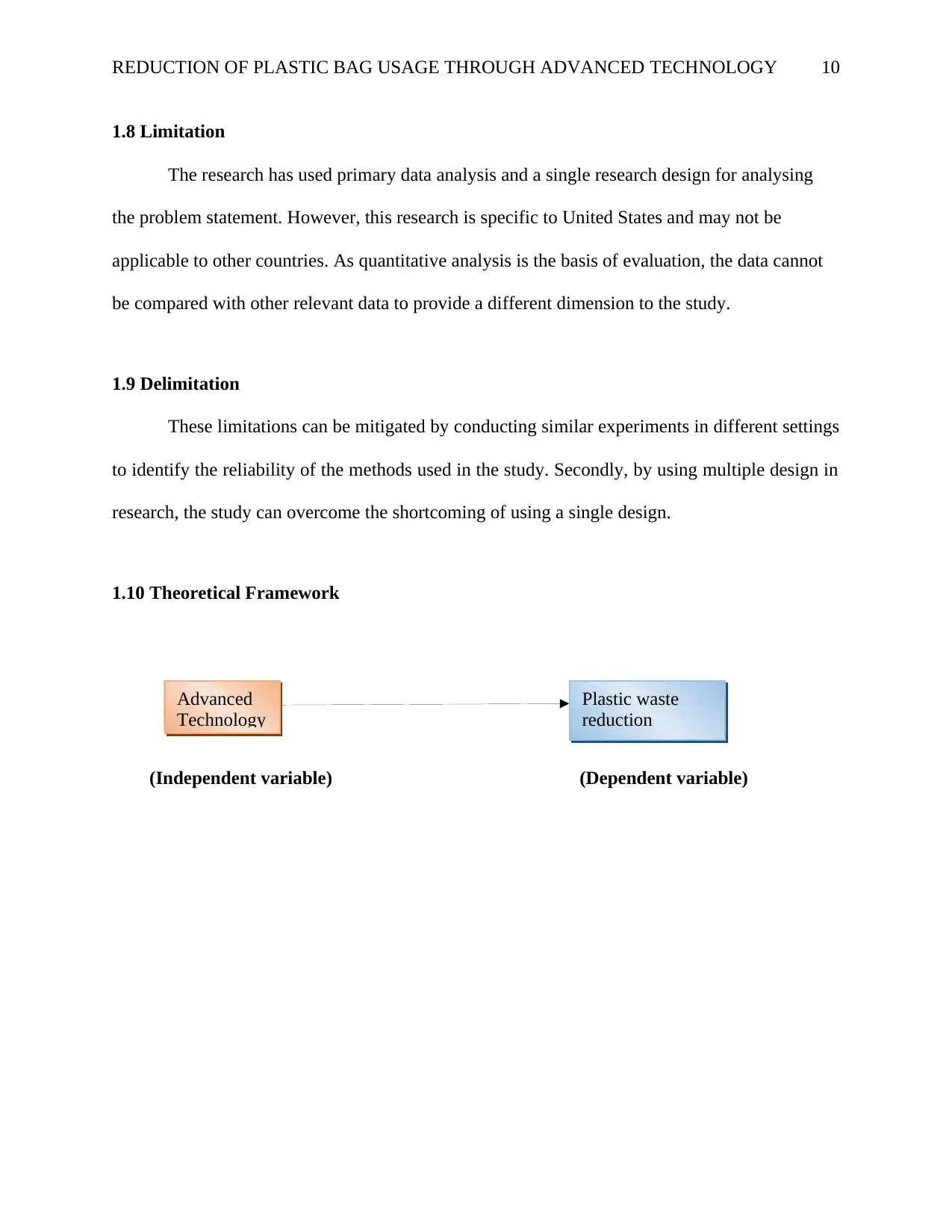
REDUCTION OF PLASTIC BAG USAGE THROUGH ADVANCED TECHNOLOGY 10
1.8 Limitation
The research has used primary data analysis and a single research design for analysing
the problem statement. However, this research is specific to United States and may not be
applicable to other countries. As quantitative analysis is the basis of evaluation, the data cannot
be compared with other relevant data to provide a different dimension to the study.
1.9 Delimitation
These limitations can be mitigated by conducting similar experiments in different settings
to identify the reliability of the methods used in the study. Secondly, by using multiple design in
research, the study can overcome the shortcoming of using a single design.
1.10 Theoretical Framework
(Independent variable) (Dependent variable)
Advanced
Technology
Plastic waste
reduction
1.8 Limitation
The research has used primary data analysis and a single research design for analysing
the problem statement. However, this research is specific to United States and may not be
applicable to other countries. As quantitative analysis is the basis of evaluation, the data cannot
be compared with other relevant data to provide a different dimension to the study.
1.9 Delimitation
These limitations can be mitigated by conducting similar experiments in different settings
to identify the reliability of the methods used in the study. Secondly, by using multiple design in
research, the study can overcome the shortcoming of using a single design.
1.10 Theoretical Framework
(Independent variable) (Dependent variable)
Advanced
Technology
Plastic waste
reduction
Paraphrase This Document
Need a fresh take? Get an instant paraphrase of this document with our AI Paraphraser
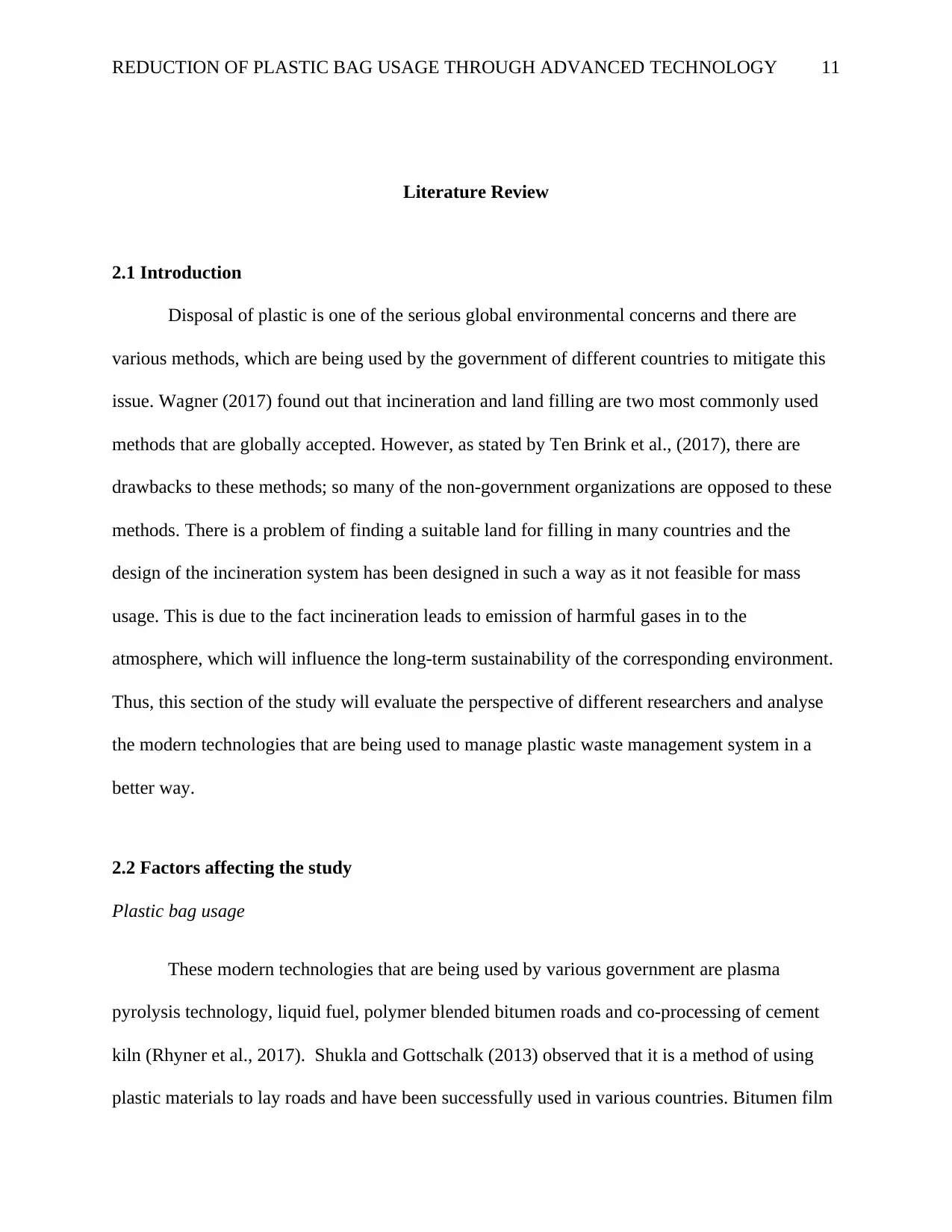
REDUCTION OF PLASTIC BAG USAGE THROUGH ADVANCED TECHNOLOGY 11
Literature Review
2.1 Introduction
Disposal of plastic is one of the serious global environmental concerns and there are
various methods, which are being used by the government of different countries to mitigate this
issue. Wagner (2017) found out that incineration and land filling are two most commonly used
methods that are globally accepted. However, as stated by Ten Brink et al., (2017), there are
drawbacks to these methods; so many of the non-government organizations are opposed to these
methods. There is a problem of finding a suitable land for filling in many countries and the
design of the incineration system has been designed in such a way as it not feasible for mass
usage. This is due to the fact incineration leads to emission of harmful gases in to the
atmosphere, which will influence the long-term sustainability of the corresponding environment.
Thus, this section of the study will evaluate the perspective of different researchers and analyse
the modern technologies that are being used to manage plastic waste management system in a
better way.
2.2 Factors affecting the study
Plastic bag usage
These modern technologies that are being used by various government are plasma
pyrolysis technology, liquid fuel, polymer blended bitumen roads and co-processing of cement
kiln (Rhyner et al., 2017). Shukla and Gottschalk (2013) observed that it is a method of using
plastic materials to lay roads and have been successfully used in various countries. Bitumen film
Literature Review
2.1 Introduction
Disposal of plastic is one of the serious global environmental concerns and there are
various methods, which are being used by the government of different countries to mitigate this
issue. Wagner (2017) found out that incineration and land filling are two most commonly used
methods that are globally accepted. However, as stated by Ten Brink et al., (2017), there are
drawbacks to these methods; so many of the non-government organizations are opposed to these
methods. There is a problem of finding a suitable land for filling in many countries and the
design of the incineration system has been designed in such a way as it not feasible for mass
usage. This is due to the fact incineration leads to emission of harmful gases in to the
atmosphere, which will influence the long-term sustainability of the corresponding environment.
Thus, this section of the study will evaluate the perspective of different researchers and analyse
the modern technologies that are being used to manage plastic waste management system in a
better way.
2.2 Factors affecting the study
Plastic bag usage
These modern technologies that are being used by various government are plasma
pyrolysis technology, liquid fuel, polymer blended bitumen roads and co-processing of cement
kiln (Rhyner et al., 2017). Shukla and Gottschalk (2013) observed that it is a method of using
plastic materials to lay roads and have been successfully used in various countries. Bitumen film
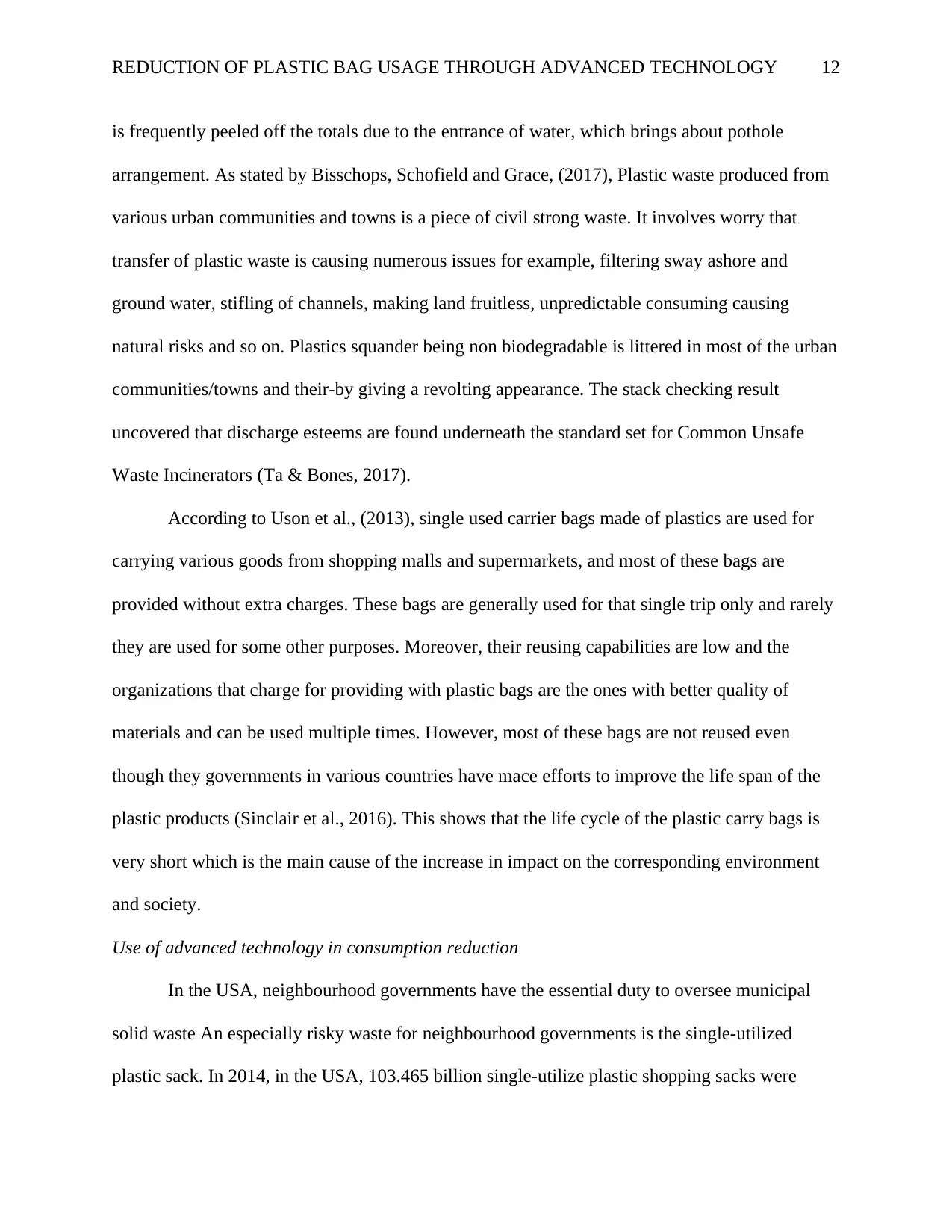
REDUCTION OF PLASTIC BAG USAGE THROUGH ADVANCED TECHNOLOGY 12
is frequently peeled off the totals due to the entrance of water, which brings about pothole
arrangement. As stated by Bisschops, Schofield and Grace, (2017), Plastic waste produced from
various urban communities and towns is a piece of civil strong waste. It involves worry that
transfer of plastic waste is causing numerous issues for example, filtering sway ashore and
ground water, stifling of channels, making land fruitless, unpredictable consuming causing
natural risks and so on. Plastics squander being non biodegradable is littered in most of the urban
communities/towns and their-by giving a revolting appearance. The stack checking result
uncovered that discharge esteems are found underneath the standard set for Common Unsafe
Waste Incinerators (Ta & Bones, 2017).
According to Uson et al., (2013), single used carrier bags made of plastics are used for
carrying various goods from shopping malls and supermarkets, and most of these bags are
provided without extra charges. These bags are generally used for that single trip only and rarely
they are used for some other purposes. Moreover, their reusing capabilities are low and the
organizations that charge for providing with plastic bags are the ones with better quality of
materials and can be used multiple times. However, most of these bags are not reused even
though they governments in various countries have mace efforts to improve the life span of the
plastic products (Sinclair et al., 2016). This shows that the life cycle of the plastic carry bags is
very short which is the main cause of the increase in impact on the corresponding environment
and society.
Use of advanced technology in consumption reduction
In the USA, neighbourhood governments have the essential duty to oversee municipal
solid waste An especially risky waste for neighbourhood governments is the single-utilized
plastic sack. In 2014, in the USA, 103.465 billion single-utilize plastic shopping sacks were
is frequently peeled off the totals due to the entrance of water, which brings about pothole
arrangement. As stated by Bisschops, Schofield and Grace, (2017), Plastic waste produced from
various urban communities and towns is a piece of civil strong waste. It involves worry that
transfer of plastic waste is causing numerous issues for example, filtering sway ashore and
ground water, stifling of channels, making land fruitless, unpredictable consuming causing
natural risks and so on. Plastics squander being non biodegradable is littered in most of the urban
communities/towns and their-by giving a revolting appearance. The stack checking result
uncovered that discharge esteems are found underneath the standard set for Common Unsafe
Waste Incinerators (Ta & Bones, 2017).
According to Uson et al., (2013), single used carrier bags made of plastics are used for
carrying various goods from shopping malls and supermarkets, and most of these bags are
provided without extra charges. These bags are generally used for that single trip only and rarely
they are used for some other purposes. Moreover, their reusing capabilities are low and the
organizations that charge for providing with plastic bags are the ones with better quality of
materials and can be used multiple times. However, most of these bags are not reused even
though they governments in various countries have mace efforts to improve the life span of the
plastic products (Sinclair et al., 2016). This shows that the life cycle of the plastic carry bags is
very short which is the main cause of the increase in impact on the corresponding environment
and society.
Use of advanced technology in consumption reduction
In the USA, neighbourhood governments have the essential duty to oversee municipal
solid waste An especially risky waste for neighbourhood governments is the single-utilized
plastic sack. In 2014, in the USA, 103.465 billion single-utilize plastic shopping sacks were
⊘ This is a preview!⊘
Do you want full access?
Subscribe today to unlock all pages.

Trusted by 1+ million students worldwide
1 out of 45
Related Documents
Your All-in-One AI-Powered Toolkit for Academic Success.
+13062052269
info@desklib.com
Available 24*7 on WhatsApp / Email
![[object Object]](/_next/static/media/star-bottom.7253800d.svg)
Unlock your academic potential
Copyright © 2020–2025 A2Z Services. All Rights Reserved. Developed and managed by ZUCOL.




